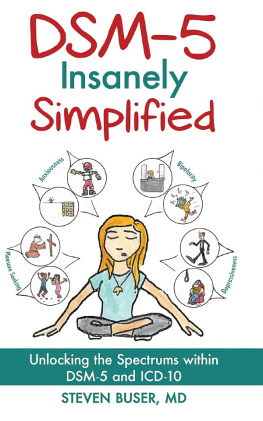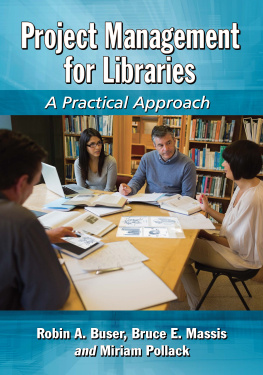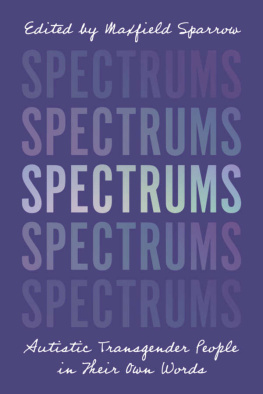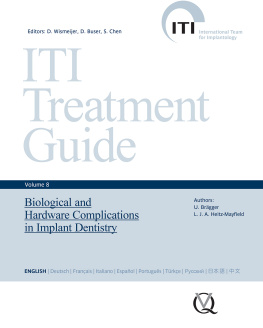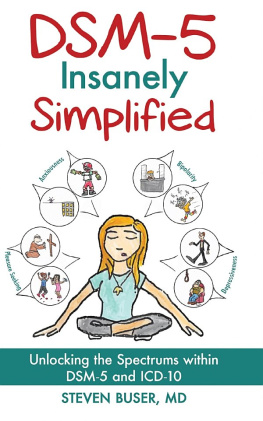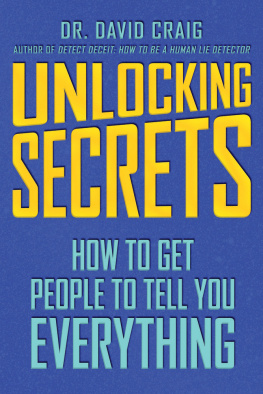Buser Steven - DSM-5 Insanely Simplified: Unlocking the Spectrums Within DSM-5 and ICD-10
Here you can read online Buser Steven - DSM-5 Insanely Simplified: Unlocking the Spectrums Within DSM-5 and ICD-10 full text of the book (entire story) in english for free. Download pdf and epub, get meaning, cover and reviews about this ebook. year: 2015, publisher: innerQuest, genre: Home and family. Description of the work, (preface) as well as reviews are available. Best literature library LitArk.com created for fans of good reading and offers a wide selection of genres:
Romance novel
Science fiction
Adventure
Detective
Science
History
Home and family
Prose
Art
Politics
Computer
Non-fiction
Religion
Business
Children
Humor
Choose a favorite category and find really read worthwhile books. Enjoy immersion in the world of imagination, feel the emotions of the characters or learn something new for yourself, make an fascinating discovery.
- Book:DSM-5 Insanely Simplified: Unlocking the Spectrums Within DSM-5 and ICD-10
- Author:
- Publisher:innerQuest
- Genre:
- Year:2015
- Rating:4 / 5
- Favourites:Add to favourites
- Your mark:
- 80
- 1
- 2
- 3
- 4
- 5
DSM-5 Insanely Simplified: Unlocking the Spectrums Within DSM-5 and ICD-10: summary, description and annotation
We offer to read an annotation, description, summary or preface (depends on what the author of the book "DSM-5 Insanely Simplified: Unlocking the Spectrums Within DSM-5 and ICD-10" wrote himself). If you haven't found the necessary information about the book — write in the comments, we will try to find it.
Buser Steven: author's other books
Who wrote DSM-5 Insanely Simplified: Unlocking the Spectrums Within DSM-5 and ICD-10? Find out the surname, the name of the author of the book and a list of all author's works by series.
DSM-5 Insanely Simplified: Unlocking the Spectrums Within DSM-5 and ICD-10 — read online for free the complete book (whole text) full work
Below is the text of the book, divided by pages. System saving the place of the last page read, allows you to conveniently read the book "DSM-5 Insanely Simplified: Unlocking the Spectrums Within DSM-5 and ICD-10" online for free, without having to search again every time where you left off. Put a bookmark, and you can go to the page where you finished reading at any time.
Font size:
Interval:
Bookmark:
2014 by Chiron Publications. All rights reserved. No part of this publication may be reproduced, stored in a retrieval system, or transmitted, in any form by any means, electronic, mechanical, photocopying, recording, or otherwise, without the prior written permission of the publisher, Chiron Publications, 932 Hendersonville Road, Suite 104, Asheville, North Carolina 28803.
www.ChironPublicatons.com
innerQuest is a book imprint of Chiron Publications
Printed in the United States of America
ISBN 978-1-63051-207-1 paperback
ISBN 978-1-63051-208-8 clothbound
ISBN 978-1-63051-209-5 electronic
Library of Congress Cataloging-in-Publication Data
Buser, Steven, 1963- , author.
DSM-5 insanely simplied : unlocking the spectrums within DSM-5 & ICD 10 / Steven Buser, Leonard Cruz.
p. ; cm.
Includes bibliographical references and index.
ISBN 978-1-63051-207-1 (pbk. : alk. paper) -- ISBN 978-1-63051-208-8 (clothbound : alk. paper) -- ISBN 978-1-63051-209-5 (electronic)
I. Cruz, Leonard, 1957- , author. II. Title.
[DNLM: 1. Diagnostic and statistical manual of mental disorders. 5th ed. 2. International statistical classication of diseases and related health problems. 10th revision. 3. Mental Disorders--classification--Handbooks. 4. Mental Disorders--diagnosis--Handbooks. WM 34]
RC455.2.C4
616.89075--dc23
2014041424
To our wives, Megan and Vicky, and our children,
Brian, Emily, Saila and Sarah
And all their amazing love and inspiration
that fuel our lifes work.
WARNING! The description of DSM-5 disorders that follows are in a highly simplified and summarized form. They are meant to give a quick overview and a reminder of the disorder. They do not, however, include all of the full diagnostic criterion found in the complete DSM-5 text. The DSM-5 should be purchased as a separate side-by-side text. Please do not use our book to formally reach a diagnosis, but rather as a quick reference and memory tool. All codes begin with DSM-5 and following the backslash include ICD-10 codes. Most of which begin with the letter F
Major Depressive Disorder
5 SIG E CAPSS symptoms for at least 2 weeks [Sadness, Interest loss, Guilt or worthlessness, Energy loss, Concentration loss, Appetite change, Psychomotor agitation or retardation, Sleep change, Suicidal thoughts]
296.2x / F32.x Major Depressive Disorder, single episode
296.3x / F33.x Major Depressive Disorder, recurrent
| Intensity: | Single Episode: | Recurrent Episode: |
| Mild | 296.21 / F32.0 | 296.31 / F33.0 |
| Moderate | 296.22 / F32.1 | 296.32 / F33.1 |
| Severe | 296.23 / F32.2 | 296.33 / F33.2 |
| Psychotic | 296.24 / F32.3 | 296.34 / F33.3 |
300.4 / F34.1 Persistent Depressive Disorder (Dysthymia)
Sad most days for 2 years
2 or more of: sleep change, hopelessness, appetite change, low self-esteem, concentration loss
Never 2 months symptom free in first 2 years
Significant distress or impairment
296.99 / F34.8 Disruptive Mood Dysregulation Disorder
Severe recurrent temper outbursts (verbal or physical)
Out of proportion to context
3 or more per week; persists more than a year; began as child (6-18)
Persistent irritability
(not better explained by mania, depression, autism, substance abuse, etc)
625.4 / N94.3 Premenstrual Dysphoric Disorder
Symptoms present one week prior to menses
At least 1 of the 4 following: mood swings, irritability/anger, sadness, anxiety/tension
At least 5 total: mood swings, irritability/anger, sadness, anxiety/tension, loss of interest, poor concentration, fatigue, appetite change, sleep change, overwhelmed, physical symptoms (breast tenderness, bloating, pain, weight gain)
Significant distress or impairment
296.7 / F31.9 Bipolar I Disorder
Euphoric or irritable mood and increased energy or activity for 1 week
3 out of 7: grandiose, decreased sleep, talkative, racing thoughts, distractibility, increased goal-directed activity, impulsive)
Social or work impairment
296.89 / F31.81 Bipolar II Disorder
At least 1 Hypomanic episode and at least 1 Major Depressive episode
No full Manic episodes
Hypomanic Episode:
Same as Bipolar I Manic episode except: at least 4 days duration (instead of 7)
And NO marked impairment in social or occupational functioning
301.13 / F34.0 Cyclothymic Disorder
Numerous hypomania and depression symptoms for most of the time for 2 years
Never reaches full diagnosis for either hypomanic, manic or depressive episodes
Not without symptoms for 2 months in 1st 2 years.
Clinically significant distress or impairment
May Add Specifiers:
with Anxious Distress
with Mixed Features (mania and depression)
with Rapid Cycling (for Bipolar I and II: > 4 episodes per year)
with Melancholic Features (loss of pleasure, lack of reactivity, despair, worse in a.m., early morning awakening)
with Atypical Features (weight gain, increased sleep, leaden paralysis, interpersonal rejection sensitivity, mood reactivity)
with Psychotic Features, with Catatonia, with Peripartum Onset, with Seasonal Pattern
295.90 / F20.9 Schizophrenia
Must have 1 positive symptom (hallucinations, delusions or disorganized speech) for 1 month
2 of the following: hallucinations, delusions, disorganized speech, disorganized behavior, or negative symptoms (low emotion, low motivation)
Prior or residual poor functioning for at least 6 months
Social or work impairment
295.40 / F20.81 Schizophreniform Disorder
Schizophrenic symptoms between 1-6 months duration
295.70 / F25.0 Schizoaffective Disorder, Bipolar type
Schizophrenic symptoms and Bipolar I symptoms present most of the time.
At least 2 weeks of delusions or hallucinations without Bipolar symptoms
Must have Bipolar symptoms for the majority of time.
295.70 / F25.1 Schizoaffective Disorder, Depressive type
Schizophrenic symptoms and Depression symptoms present most of the time.
At least 2 weeks of delusions or hallucinations without Depression symptoms
Must have Depression symptoms for the majority of time.
297.1 / F22 Delusional Disorder
Moderate delusions at least 1 month, not Schizophrenic level
Otherwise good functioning; no bizarre behavior
Erotomanic type
Grandiose type
Jealous type
Persecutory type
Somatic type
Mixed type
Unspecified type
298.8 / F23 Brief Psychotic Disorder
Schizophrenic symptoms for less than 1 month
Full return to premorbid level.
with marked stressors
without marked stressors
with postpartum onset
with Catatonia
300.01 / F41.0 Panic Disorder
Recurrent, abrupt, unexpected intense fear or discomfort
Persistent worry of additional attacks for 1 month
4 out of 13 symptoms: (palpitations, sweating, trembling, shortness of breath, choking, chest pain, nausea, dizziness, derealization, fear of going crazy, fear of dying, numbness/tingling, hot/cold flashes)
Panic Attack can also be a specifier for other diagnoses (i.e. PTSD with Panic Attacks)
300.22 / F40.00 Agoraphobia
Intense fear of 2 or more of: public transportation, open spaces (markets, bridges), enclosed spaced (theaters, shops), crowds, being away from home.
Font size:
Interval:
Bookmark:
Similar books «DSM-5 Insanely Simplified: Unlocking the Spectrums Within DSM-5 and ICD-10»
Look at similar books to DSM-5 Insanely Simplified: Unlocking the Spectrums Within DSM-5 and ICD-10. We have selected literature similar in name and meaning in the hope of providing readers with more options to find new, interesting, not yet read works.
Discussion, reviews of the book DSM-5 Insanely Simplified: Unlocking the Spectrums Within DSM-5 and ICD-10 and just readers' own opinions. Leave your comments, write what you think about the work, its meaning or the main characters. Specify what exactly you liked and what you didn't like, and why you think so.

